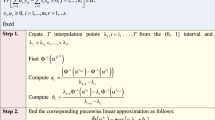Abstract
DEA (Data Envelopment Analysis) models and concepts are formulated here in terms of the “P-Models” of Chance Constrained Programming, which are then modified to contact the “satisficing concepts” of H.A. Simon. Satisficing is thereby added as a third category to the efficiency/inefficiency dichotomies that have heretofore prevailed in DEA. Formulations include cases in which inputs and outputs are stochastic, as well as cases in which only the outputs are stochastic. Attention is also devoted to situations in which variations in inputs and outputs are related through a common random variable. Extensions include new developments in goal programming with deterministic equivalents for the corresponding satisficing models under chance constraints.
Similar content being viewed by others
References
Banker, R.D., Maximum likelihood, consistency and DEA: Statistical foundations, Management Science 39, 1993, 1265–1273.
Banker, R.D., Stochastic data envelopment analysis, Working Paper, Carnegie-Mellon University School of Urban and Public Affairs, Pittsburgh, PA, 1986.
Banker, R.D. and W.W. Cooper, Validation and generalization of DEA and its uses, TOP 2, 1994, 249–296.
Banker, R.D., A. Charnes and W.W. Cooper, Some models for estimating technical and scale inefficiencies in data envelopment analysis, Management Science 30, 1984, 1078–1092.
Banker, R.D., A. Charnes, W.W. Cooper, J. Swarts and D.A. Thomas, An introduction to data envelopment analysis with some of its models and their uses, Research in Governmental and Nonprofit Accounting 5, 1989, 125–163.
Charnes, A. and W.W. Cooper, Deterministic equivalents for optimizing and satisficing under chance constraints, Operations Research 11, 1963, 18–39.
Charnes, A. and W.W. Cooper,Management Models and Industrial Applications of Linear Programming, Wiley, New York, 1961
Charnes, A. and W.W. Cooper, Goal programming and multiple objective optimizations, European Journal of Operational Research 1, 1977, 39–54.
Charnes, A. and W.W. Cooper, Preface to topics in data envelopment analysis, Annals of Operations Research 2, 1985, 59–94.
Charnes, A. and W. W. Cooper, Programming with linear fractional functionals, Naval Research Logistics Quarterly 9, 1962, 181–185.
Charnes, A., W.W. Cooper, J.K. DeVoe and D.B. Learner, Demon, Mark II: An extremal equation approach to new product marketing, Management Science 14, 1968, 513–524.
Charnes, A., W.W. Cooper and J. Hsu, A chance constrained programming approach to multiple-objective sample designs in auditing, Working Paper, University of Texas Graduate School of Business, Austin, TX, 1986.
Charnes, A., W.W. Cooper and E. Rhodes, Evaluating program and managerial efficiency: An application of data envelopment analysis to program follow through, Management Science 27, 1981, 668–697.
Charnes, A., W.W. Cooper and E. Rhodes, Measuring the efficiency of decision making units, European Journal of Operational Research 2, 1978, 429–444.
Charnes, A., W.W. Cooper and G.H. Symonds, Cost horizons and certainty equivalents: An approach to stochastic programming of heating oil, Management Science 4, 1958, 235–236.
Cooper, W.W., Z.M. Huang and S.X. Li, Chance constrained programming formulations for stochastic characterizations of efficiency and dominance in DEA, Journal of Productivity Analysis (submitted, 1996).
Cooper, W.W. and Y. Ijiri (eds.),Kohler's Dictionary for Accountants, 6th ed., Prentice-Hall, Englewood Cliffs, NJ, 1983.
Desai, A.A. and A.P. Schinnar, Stochastic data envelopment analysis, Working Paper, The Ohio State University, 1987.
Jagannathan, R., Use of sample information in stochastic recourse and chance constrained programming, Management Science 31, 1985, 96–108.
Kahane, Y., Determination of the product mix and the business policy of an insurance company — a portfolio approach, Management Science 23, 1977, 1060–1069.
Land, K.C., C.A.K. Lovell and S. Thore, Chance-constrained data envelopment analysis, Managerial and Decision Economics 14, 1993, 541–554.
Land, K., C.A.K. Lovell and S. Thore, Productive efficiency under capitalism and state socialism: An empirical inquiry using chance-constrained data envelopment analysis, Technological Forecasting and Social Change 46, 1994, 139–152.
Land, K., C.A.K. Lovell and S. Thore, Productive efficiency under capitalism and state socialism: The chance-constrained programming approach,Public Finance in a World of Transition, Proceedings of the 47th Congress of the International Institute of Public Finance, P. Pestieau, ed., 1992, supplement to Public Finance/Finances Publique 47, 1992, 109–121.
Leibenstein, H.,Beyond Economic Man, Harvard University Press, Cambridge, 1976.
Rhodes, E., Data envelopment analysis and related approaches for measuring the efficiency of decision making units with an spplication to program follow through in U.S. public school education, Ph.D. Thesis, Carnegie Mellon University School of Urban and Public Affairs, Pittsburgh, PA, 1978. Also available from Michigan University Microfilms, Inc., Ann Arbor.
Seiford, L.M. and R.M. Thrall, Recent developments in DEA: The mathematical programming approach to frontier analysis, Journal of Econometrics 46, 1990, 7–38.
Sengupta, J.K., Data envelopment analysis for efficiency measurement in the stochastic case, Computers and Operations Research 14, 1987, 117–129.
Sengupta, J.K., Data envelopment with maximum correlation, International Journal of Systems Science 20, 1989, 2085–2093.
Sengupta, J.K., Efficiency measurement in stochastic input-output systems, International Journal of Systems Science 13, 1982, 273–287.
Sengupta, J.K., Robust efficiency measures in a stochastic efficiency, International Journal of Systems Science 19, 1988, 779–791.
Sharpe, W.F., A simplified model for portfolio analysis, Management Science 9, 1963, 277–293.
Simon, H.A.,Models of Man, Wiley, New York, 1957.
Stedry, A.C.,Budget Control and Cost Behavior, Prentice-Hall, Englewood Cliffs, NJ, 1960.
Stigler, G.J., The Xistence of X-efficiency, American Economic Review 66, 1976, 213–216.
Wagner, H.M.,Principles of Operations Research, Prentice-Hall, Englewood Cliffs, NJ, 1969.
Author information
Authors and Affiliations
Rights and permissions
About this article
Cite this article
Cooper, W.W., Huang, Z. & Li, S.X. Chapter 13 Satisficing DEA models under chance constraints. Ann Oper Res 66, 279–295 (1996). https://doi.org/10.1007/BF02187302
Issue Date:
DOI: https://doi.org/10.1007/BF02187302





